UMass Extension's Landscape Message is an educational newsletter intended to inform and guide Massachusetts land care professionals in the management of our collective landscape. Detailed reports from scouts and Extension specialists on growing conditions, pest activity, and cultural practices for the management of woody ornamentals, trees, and turf are regular features. The following issue has been updated to provide timely management information and the latest regional news and environmental data.
Welcome to Landscape Message #17 for the 2024 growing season. We are now in the bi-weekly phase of the annual schedule, and the next message will be posted on Friday, September 20. To receive immediate notification when the next Landscape Message update is posted, be sure to join our e-mail list
Click on the headings below to jump to that section of the message.
In This Issue
Scouting Information by Region
Woody Ornamentals
Scouting Information by Region
Environmental Data
The following data was collected on or about September 4, 2024. Total accumulated growing degree days (GDD) represent the heating units above a 50ºF baseline temperature collected via regional NEWA stations (http://newa.cornell.edu) for the 2024 calendar year. This information is intended for use as a guide for monitoring the developmental stages of pests in your location and planning management strategies accordingly.
|
MA Region/Location |
2024 Growing Degree Days |
Soil Temp |
Precipitation |
Time/Date of Readings |
||
| Gain since last report |
2024 total |
Sun |
Shade |
|||
|
CAPE |
234 |
2232 |
70 |
67 |
0.18 |
12:00 PM 9/4/2024 |
|
SOUTHEAST |
253 |
2519 |
74 |
67 |
0.00 |
3:00 PM 9/4/2024 |
|
NORTH SHORE |
240 |
2303 |
64 |
59 |
0.00 |
10:00 AM 9/4/2024 |
|
EAST |
257 |
2520 |
67 |
58 |
0.00 |
4:00 PM 9/4/2024 |
|
METRO |
236 |
2371 |
66 |
58 |
0.07 |
6:30 AM 9/4/2024 |
|
CENTRAL |
244 |
2409 |
66 |
62 |
0.00 |
12:00 PM 9/4/2024 |
|
PIONEER VALLEY |
147 |
2354 |
66 |
64 |
0.00 |
12:00 PM 9/4/2024 |
|
BERKSHIRES |
201 |
2125 |
65 |
58 |
0.08 |
7:00 AM 9/4/2024 |
|
AVERAGE |
259 |
2128 |
70 |
64 |
2.33 |
- |
|
n/a = information not available |
||||||
US Drought Monitor: At this time, approximately the northern half of Essex county and all of Nantucket are classified as "D0 - Abnormally Dry" (about 4% of the state's area in total). State map as of Thursday 9/5: https://droughtmonitor.unl.edu/CurrentMap/StateDroughtMonitor.aspx?MA
Phenology
| Indicator Plants - Stages of Flowering (BEGIN, BEGIN/FULL, FULL, FULL/END, END) | ||||||||
|---|---|---|---|---|---|---|---|---|
| PLANT NAME (Botanic / Common) | CAPE | S.E. | N.S. | EAST | METRO W. | CENT. | P.V. | BERK. |
|
Heptacodium miconioides (seven son flower) |
Begin |
* |
* |
Begin |
* |
Begin |
Begin/Full |
Begin |
|
Clematis terniflora (sweet autumn clematis) |
Begin/Full |
Full |
Full |
Begin/Full |
Full |
Full |
Full |
Begin |
|
Fallopia japonica (syn. Polygonum cuspidatum) (Japanese knotweed) |
Full |
Full |
Full |
Full |
Full |
Full |
Full |
Full |
| * = no activity to report/information not available | ||||||||
Regional Notes
Cape Cod Region (Barnstable)
General Conditions:
The average temperature for the period from August 21 thru September 4 was 68ºF with a high of 86ºF on August 28 and a low of 48ºF on September 4. The period has been seasonable with warm days and cool nights, several days feeling like mid-summer and several days beckoning autumn. Precipitation has been minimal, with less than a quarter inch during the period. Evapotranspiration rates have been relatively high as well. Soil moisture is dry to short.
Herbaceous plants seen in bloom during the period include cardinal flower (Lobelia cardinalis), sneezeweed (Helenium autumnale), purple Joe-Pye weed (Eutrochium purpureum), Russian sage (Salvia yangii), and bluebeard (Caryopteris incana). Woody plants seen in bloom include hydrangea (H. macrophylla and H. paniculata), glossy abelia (Abelia x grandiflora), harlequin glorybower (Clerodendrum trichotomum), and Franklinia (Franklinia alatamaha).
Pests/Problems:
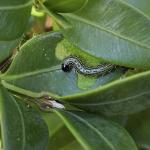
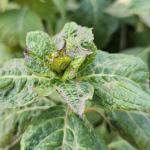


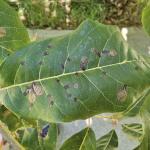
 Soil moisture is less than ideal during an important time of lawn renovation, planting and transplanting. The 6-10 day outlook also predicts below normal precipitation. Whether to hold off on such projects or dedicating to supplemental watering is a tough decision.
Soil moisture is less than ideal during an important time of lawn renovation, planting and transplanting. The 6-10 day outlook also predicts below normal precipitation. Whether to hold off on such projects or dedicating to supplemental watering is a tough decision.
Box tree moth is still active, and both adult moths and young caterpillars have been observed (I believe this is the beginning of a third generation from my observations).
Insects or insect damage observed during the period include turpentine beetle on pitch pine, chilli thrips damage to big leaf hydrangea, sycamore lace bug damage on sycamore, two spotted spider mites on various herbaceous and woody plants, tuliptree spot gall on tuliptree, fall webworm on crabapple and black gum, leafminer on black gum, leaf roller/tier damage on witch-hazel, hemlock elongate scale on hemlock, oleander aphids on milkweed, hibiscus sawfly damage on hibiscus, and sunflower moth damage on purple coneflower. The chorus of katydids and crickets is strong at night.
Disease symptoms or signs observed during the period include powdery mildew on numerous hosts, beech leaf disease on beech, cercospora leaf spot on bigleaf hydrangea, hydrangea rust on smooth hydrangea, gray leaf spot on Japanese forest grass, venturia leaf spot on poplar, cedar apple rust on crabapple, pear trellis rust on Bradford pear, septoria leaf spot on Rudbeckia, hollyhock rust on hollyhock, foliar nematode on hosta and astrantia, guignardia leaf spot on horsechestnut, and leaf spot on black locust.
Other issues observed in the landscape include scorch on dogwoods, rabbit damage to annuals and perennials, deer browse of hosta, and slug and snail damage to perennials.
Weeds seen in bloom during the period include carpetweed (Mollugo verticillata), spotted spurge (Euphorbia maculata), redroot pigweed (Amaranthus retroflexus), tansy ragwort (Jacobaea vulgaris) and yellow wood sorrel (Oxalis stricta).
Southeast Region (Dighton)
General Conditions:
Over the past two weeks, the weather has transitioned from summer to fall. Along with late summer flowers, some trees and shrubs are beginning to show fall colors. Japanese knotweed is putting on a show along the roadside, much to the delight of beekeepers when nectar sources are scarce. Hummingbirds, while still present, are hungrily revisiting the same few flowers. Songbirds have flocked up. We experienced a high temperature of 90ºF on Wednesday, August 28th, and a low of 55ºF on the morning of Friday, August 30th. The average temperature was 68ºF. Precipitation was scarce, with only very light and intermittent showers, resulting in no measurable accumulation. Humidity averaged 74%. The highest wind speed was 12 mph. The soil temperature on September 4th at 3:00 PM was 74ºF in full sun and 67ºF in the shade.
Among the plants in flower are Buddleia davidii (butterfly bush), Campsis radicans (trumpet vine), Clematis paniculata (sweet autumn clematis), Clethra alnifolia (summersweet clethra), Hibiscus syriacus (rose-of-Sharon), and Polygonum cuspidatum (Japanese knotweed).
Pests/Problems:
A spotted lanternfly infestation has been discovered in Seekonk. We should all be vigilant for other infestations.
County mosquito projects have raised alarms about eastern equine encephalitis (EEE) and West Nile virus (WNV) found in their traps and have begun spraying. Workers should use insect repellent and avoid hours when mosquitoes are most active if possible.
North Shore (Beverly)
General Conditions:
The weather during this two-week reporting period was very pleasant for outdoor activities. Most days were bright and sunny with very little cloud cover. Day temperatures ranged from the low 70s to mid 80s and night temperatures ranged from the low 50s to mid 60s. The daily average air temperature was 67ºF with a maximum air temperature of 88ºF recorded on August 28. The minimum was 49ºF, recorded on August 30. No rainfall was recorded at Long Hill during this two-week period.
Woody plants seen in bloom include Franklin tree (Franklinia alatamaha) and panicle hydrangea (Hydrangea paniculata). Herbaceous plants seen in bloom include Joe-Pye weed (Eutrochium purpureum), garden phlox (Phlox paniculata), black-eyed Susan (Rudbeckia hirta), Japanese anemone (Anemone x hybrida), hardy begonia (Begonia grandis), hardy geranium or cranes bill (Geranium spp.), and coneflower (Echinacea spp.). Various kinds of annuals are also contributing color to the landscape.
Pests/Problems:
Powdery mildew continued to be observed on lilac, garden phlox, and New England aster. Symptom of foliar nematode damage was observed on some hostas. Crabgrass and other weeds such as prostrate spurge (Euphorbia maculata), ragweed (Ambrosia artemisiifolia) and Japanese knotweed (Reynoutria japonica, syn. Polygonum cuspidatum) are thriving in the landscape. Canada goldenrod (Solidago canadensis) is in full bloom and is providing color on meadows. Mosquitoes and ticks are still active at dawn and dusk. Remember to protect yourself with repellent when working outdoors in the woods at dawn and dusk.
East (Boston)
General Conditions:
The days have become noticeably shorter as fall approaches. Mornings have been cooler requiring several hours for the sun to warm up the landscape. Over the past two weeks, daytime high temperatures have remained consistently warm, averaging 79ºF. Overnight lows have been falling, averaging 58ºF with a low of 48ºF on September 3rd. One noteworthy fact is that we received zero rainfall from August 21st through September 3rd. Late flowering perennials continue to add color to the landscape. Angelica gigas (giant Angelica), Eutrochium maculatum (Joe-Pye weed) and Helianthus tuberosus (Jeruselum artichoke) continue to attract an abundance of pollinators. Asimina triloba (pawpaw), Diospyros virginiana (persimmon) and Malus spp. (apple) fruit is ripening.
Pests/Problems:
The two week long lack of rainfall has impacted recent transplants, container gardens and unirrigated turf. Early fall color and leaf drop on Betula spp. (birch) may also be contributed to a lack of adequate precipitation. Japanese knotweed (Polygonum cuspidatum) is in full flower. Artemisia vulgaris (mugwort) continues to flower and distribute pollen throughout the landscape.
Metro West (Acton)
General Conditions:
Labor Day has come and gone, which unofficially marks the end to the summer season by bringing with it cooler overnight and pleasant daytime temperatures, noticeably shorter daytime lengths, and school buses. Signs of fall are visible in the landscape and soon enough the fall equinox will be here, arriving on September 22nd. The historical monthly average rainfall for the month of August is 3.72” and a total of 3.43” of rain was recorded. September’s average rainfall is 3.77” and a scant 0.002” of rain has been recorded for the month so far, but there have only been three September days in this reporting period.
Plants are heavy with fruit, seed, berries, and nuts. Observed in some stages of bloom are the following plants: Aster spp. (New England aster, New York aster, smoother aster, white wood aster), Chelone lyonii (pink turtlehead), Caryopteris clandonensis (blue mist spirea), Phlox carolina (Carolina phlox), P. paniculata (garden phlox), and Sedum ‘Autumn Joy’ (stonecrop).
Pests/Problems:
There has not been any significant rain recorded for this reporting period, so let’s hope that we receive more rain now that the fall planting season is now upon us. I reported above that plants are heavy with fruit, seed, berries, and nuts. This includes all plants including some unwanted guests found growing in our landscape such as Ailanthus altissima (tree of heaven), Celastrus orbiculatus (Oriental bittersweet), Cynanchum louiseae (black swallow-wort), and Phytolacca americana (common pokeweed) amongst many others.
Central Region (Boylston)
General Conditions:
Nighttime temperatures are continuing to drop, late season blooms are continuing to hang on, and summer is in its last run. With temperatures averaging 80.3ºF (highest being 92.1ºF on the 25th), nights have dropped as low as 47.5ºF (on the 3rd). Precipitation was 0 inches since the last report, creating dry conditions which have been quite different from previous ongoing rainfall. Heavier watering of newly installed plants and even previous year’s plantings seems to be the theme for the past 2 weeks.
Some plants that can be seen blooming currently are white wood aster (Eurybia divaricate), New York aster (Symphyotrichum novi-belgii), panicle hydrangeas (Hydrangea paniculata), evening primrose (Oenothera biennis), jewelweed (Impatiens capensis), rose mallow hibiscus (Hibiscus moscheutos), Joe-Pye weed (Eutrochium spp.), and goldenrod (Solidago spp.).
Pests/Problems:
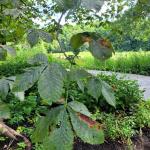 As was mentioned in general conditions, it has been extremely dry, creating dry soil conditions. However, a lot of problematic plants seem to be thriving by flowering/fruiting/going to seed including Japanese knotweed (Polygonum cuspidatum), purple loosestrife (Lythrum salicaria), and Oriental bittersweet (Celastrus orbiculatus). Some pests/problems that are seen in the landscape are early leaf drop and color change, powdery mildew, and more specifically Guignardia leaf blotch (Guignardia aesculi)... this has specifically been spotted on red horsechestnut (Aesculus x carnea 'Briotii').
As was mentioned in general conditions, it has been extremely dry, creating dry soil conditions. However, a lot of problematic plants seem to be thriving by flowering/fruiting/going to seed including Japanese knotweed (Polygonum cuspidatum), purple loosestrife (Lythrum salicaria), and Oriental bittersweet (Celastrus orbiculatus). Some pests/problems that are seen in the landscape are early leaf drop and color change, powdery mildew, and more specifically Guignardia leaf blotch (Guignardia aesculi)... this has specifically been spotted on red horsechestnut (Aesculus x carnea 'Briotii').
Pioneer Valley (Amherst)
General Conditions:
Meteorological summer has ended, and students are back on the UMass campus for the fall semester. The Labor Day weekend gave us plentiful sun and high temperatures in the 70s, which made for some downright pleasant gardening weather. The long-term forecast indicates the seasonal cooling will continue and it’s already starting to feel like autumn, with a low temperature in the upper 40s recorded on 9/3. After a blistering hot July in the tri-counties, the mild end to summer was welcome. According to WWLP, Springfield has recorded 21 days this year with temperatures >90ºF. That total includes 9 days in July, which represents almost 1/3 of the entire month. It’s been dry the past two weeks, with little to no measurable precipitation in the valley since a band of heavy showers on 8/18–19. Shorter days, decreasing sun angle, increasing shade, and lingering dew are all signals that the growing season is winding down.
Goldenrod, black-eyed Susan, panicle hydrangeas, sedums, and many others are providing late season color. Crickets, grasshoppers and katydids continue their nighttime chorus and there’s an abundance of spiders and frogs across the landscape right now. Mosquitos remain abundant, as do a variety of bees and wasps. Junipers, arborvitae, false-cypress and Japanese maples are pushing late season growth.
Pests/Problems:
The upper soil horizon is drying out due to the lack of late August rainfall, but established trees still have plentiful moisture at lower horizons. New transplants should be regularly monitored to avoid soil drying. Generally, deciduous hardwoods should be watered into late October and conifers into late November. This schedule may vary depending on natural rainfall and leaf shed for deciduous plants.
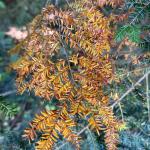 Eastern hemlocks (Tsuga canadensis) are naturally shedding a large volume of older needles right now. In many cases, entire shoots are senescing, and these needles can have a yellow to gold to brown appearance (see photo). They are not diseased but may have been weakened by adelgid and scale infestations. Based on limited studies investigating the longevity of eastern hemlock needles, it’s believed that most needles die after the third growing season. However, there are cases where trees in deep shade can retain needles for more than five years. Generally, hemlocks in full sun tend to turnover needles faster than trees in deeper shade.
Eastern hemlocks (Tsuga canadensis) are naturally shedding a large volume of older needles right now. In many cases, entire shoots are senescing, and these needles can have a yellow to gold to brown appearance (see photo). They are not diseased but may have been weakened by adelgid and scale infestations. Based on limited studies investigating the longevity of eastern hemlock needles, it’s believed that most needles die after the third growing season. However, there are cases where trees in deep shade can retain needles for more than five years. Generally, hemlocks in full sun tend to turnover needles faster than trees in deeper shade.
Leaf blotch and premature shedding is once again a problem for common lilac (Syringa vulgaris). Many plants are exhibiting pale brown to gray-colored blotches caused by the fungal pathogen Pseudocercospora. Some plants may also be harboring high levels of lilac powdery mildew, caused by Erysiphe syringae. Anthracnose fungi like Colletotrichum may also be responsible, making it a complex of different pathogens.
Chicken of the wood (Laetiporus sulphureus and L. cincinnatus) and the black-staining polypore (Meripilus sumstinei) are actively fruiting on oaks and other deciduous hardwoods.
Berkshire Region (West Stockbridge)
General Conditions:
Seemingly in an instant, we’ve gone from summer into fall the past few days. Nighttime temperatures especially took a dive into the low 40s and upper 30s. For the period, the high temperatures as recorded at the NEWA sites in Berkshire County were: 83ºF in both Richmond and Pittsfield on August 28, and 83ºF in North Adams on September 1. The lowest temperatures for the 3 sites were: 39ºF in Richmond, 41ºF in both North Adams and Pittsfield, all on the morning of September 3. Interestingly, the low of 41ºF in Pittsfield on the morning of September 3rd was only 3 degrees above the record low of 38ºF which occurred in 1938. The normal high/low temperature for Pittsfield at this time of year is 75ºF/53ºF. The forecast ahead, for a few days at least, shows a return to these norms.
While the cooldown may have been welcomed, the lack of rainfall is not. Total rain at each site over the 2-week scouting period was: 0.24 inches in North Adams, 0.22 inches in Pittsfield, 0.14 inches in Richmond, and only 0.08 at this site in West Stockbridge. The lack of rain has left soils quite dry. Nevertheless, turfgrass remains green, except where scalped, and growth steadily continues though at a slower pace. Homeowners who have a dog or dogs will see circular areas of dead grass where their pets relieved themselves. Dog urine can really do a job of killing grass.
Fall color change in the foliage of some trees and shrubs is apparent. Yet, natural and managed landscapes are colorful with late summer bloomers. One standout in many home landscapes is Hydrangea paniculata. It seems that every year, there is a particular flowering plant that seems unusually plentiful and full of blossoms. At this time, it is Hydrangea paniculata.
Pests/Problems:
Insect pest pressures are low at this time as many have completed their feeding stage and have either laid their eggs or have gone into a pupal or larval stage. A few Japanese beetles were spotted but the numbers overall this year have been quite low, at least here in the Berkshires. The larvae of boxwood leaf miner were active as indicated by tiny light-colored spots on the leaves of boxwood. Cutting open the swelled spots will reveal the larvae.
Jumping worms (Amynthas spp.) are numerous and have been throughout the summer.
The most obvious problem at this time is the abundance of foliar diseases on herbaceous and woody plants. It is imperative that diseased foliage be gathered and removed from site. Particularly noticeable is the leaf drop of crabapples infected with apple scab and cedar apple rust. Many such trees are now completely defoliated. Similarly, roses have dropped many or all of their diseased leaves. Powdery mildew is another prominent disease on the leaves of many plants.
Annoying pests such as yellow jackets, mosquitoes, flies, and biting gnats are common as are ticks. Rodents, i.e. mice and voles, are plentiful as witnessed by their tunnels in gardens and runways in turfgrass areas.
Regional Scouting Credits
- CAPE COD REGION - Russell Norton, Horticulture and Agriculture Educator with Cape Cod Cooperative Extension, reporting from Barnstable.
- SOUTHEAST REGION - Brian McMahon, Arborist, reporting from the Dighton area.
- NORTH SHORE REGION - Geoffrey Njue, Green Industry Specialist, UMass Extension, reporting from the Long Hill Reservation, Beverly.
- EAST REGION - Kit Ganshaw & Sue Pfeiffer, Horticulturists reporting from the Boston area.
- METRO WEST REGION – Julie Coop, Forester, Massachusetts Department of Conservation & Recreation, reporting from Acton.
- CENTRAL REGION - Mark Richardson, Director of Horticulture, and Anna Petrie, reporting from New England Botanic Garden at Tower Hill, Boylston.
- PIONEER VALLEY REGION - Nick Brazee, Plant Pathologist, UMass Extension Plant Diagnostic Lab, reporting from Amherst.
- BERKSHIRE REGION - Ron Kujawski, Horticultural Consultant, reporting from Great Barrington.
Woody Ornamentals
Diseases
Recent pests, pathogens, or problems of interest seen in the UMass Extension Plant Diagnostic Lab, a select few:
Annosus root rot of eastern redcedar (Juniperus virginiana) caused by Heterobasidion irregulare. Several trees in a hedge that are roughly 30 years old reside at a residential property, growing in a shaded, unmaintained backyard at the edge of a marsh. Last year, one tree died and now three surrounding trees are exhibiting symptoms of decline. Specifically, progressively worsening needle browning and canopy dieback. Heterobasidion is a destructive, yet very cryptic, root disease pathogen of conifers. Root disease centers often form in natural forests, as the pathogen radiates outward from a single or small group of infected trees. It’s role in the death of forest and landscape trees in the northeast is hard to estimate, given that it’s very difficult to find, even with deliberate scouting. The fungus creates perennial conks, but they are produced from lateral roots underneath a layer of organic matter and have a dark brown upper surface (pileus) that is well camouflaged. As a slowly developing white rot pathogen, infected roots have wood that is bleached and stringy with black flecks of fungal tissue embedded. The symptoms of Anossus root rot, like many root diseases, are very general and manifest as water starvation, upper canopy dieback, or needle blight. Furthermore, excavation and dissection of the roots often does not occur when landscape trees die. Heterobasidion is most often found in declining plantations of red pine (Pinus resinosa), which are increasingly rare in southern New England. It can also be found on pitch pine (P. rigida) and eastern white pine (P. strobus). Healthy conifers are mostly resistant to the pathogen but drought stress on sandy soils can make them susceptible. In this case, excess soil moisture may be a predisposing factor. There are other documented cases of Heterobasidion on eastern redcedar and arborvitae (Thuja occidentalis) in managed landscapes.
Twig and branch cankering of sugar maple (Acer saccharum) caused by the fungal pathogen Stegonsporium. Two trees at different properties, one approximately 20 years old and the other’s age is unknown but is old and mature (100’ tall). Stegonsporium is often found on weakened and declining sugar maples that have various predisposing health issues. The fungus extrudes circular, mounded, black-colored masses of pigmented spores that are very conspicuous on dead branches and twigs. The 20-year-old tree has a thinning canopy and a restricted root zone between a driveway and house. The root flare is not visible on one side and the managing arborist suspects girdling roots have developed from deep planting. The old and mature tree has dead shoot tips throughout the upper canopy. It underwent a crown reduction near a home and cables were installed five years ago. It experiences full sun in loam soils and has been otherwise healthy in recent years. Presently, predisposing stresses that would have weakened the tree remain unknown.
Various hybrid (Rhododendron sp.) and rosebay rhododendron (Rhododendron maximum) samples with a variety of diseases and abiotic stresses. Specifically, 10 unique samples have been received in recent weeks with the following diseases: (1) gray leaf blight caused by Pestalotiopsis, (2) shoot tip dieback and branch cankering caused by Phomopsis and/or Botryosphaeria (co-occurring in some cases), (3) leaf blotch and blight caused by Phyllosticta, (4) marginal leaf blight and stem cankering caused by Phytophthora, (5) edema from overwatering, (6) and iron (and/or manganese) deficiency. Many of these were nursery plants or recently transplanted within the last one to two years. As one of the most widely grown and shipped woody plants, rhododendrons harbor numerous diseases. While Phytophthora can be lethal to rhododendron, many plants may suffer only foliar lesions and scattered shoot tip dieback. Transplant shock and winter injury often predispose plants to attack from foliar pathogens like Phyllosticta and Pestalotiopsis. Opportunistic cankering pathogens are also routinely found on stressed rhododendrons. Ensuring proper soil pH for optimal growth can help ease the shock of transplant and an avoidance of overwatering is also important.
Report by Nick Brazee, Plant Pathologist, UMass Extension Plant Diagnostic Lab, UMass Amherst
Insects and Other Arthropods
The Professional Insect and Mite Management Guide for Woody Plants is freely available at https://ag.umass.edu/insectmiteguide. Please let me know how it is or isn’t working for you by responding to the following Feedback Form: Professional Insect & Mite Management Guide for Woody Plants. Your feedback is valuable and I cannot wait to hear from you!
Note: Our website is undergoing updates, and as such, the collapsible menus on the home page of the Guide are currently not functioning. Thank you for your patience as we await these updates.
Interested in pollinators? Then you may be interested in a new quarterly UMass Extension newsletter: The Pollinator Buzz! Subscribe to receive the latest updates about pollinator health, outreach events, and conservation opportunities. Typical features will include native plant and bee species profiles, hot topics in bee conservation, upcoming event announcements, and more!
See http://ag.umass.edu/resources/pollinators/native-pollinators-conservation/pollinator-buzz for more info, and to subscribe
Invasive Updates:
- Asian Longhorned Beetle is still present in Worcester, Shrewsbury, Boylston, West Boylston, and parts of Holden and Auburn, MA. If you suspect you’ve found this insect or the damage it causes, please report it to the Asian Longhorned Beetle Eradication Program office in Worcester, MA at 508-852-8090 or toll free at 1-866-702-9938.
To report an Asian longhorned beetle find online or to compare it to common insect look-alikes, visit the Asian Longhorned Beetle Report page from the MA Department of Agricultural Resources.
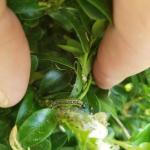


 Box Tree Moth has been detected in the following Massachusetts communities: Plymouth, Bourne, Sandwich, Barnstable, and Yarmouth. A map of these locations is available at MDAR’s Invasive Pest Dashboard. If you believe you have found this insect, please take a photo, note your location, and report it immediately to the MA Department of Agricultural Resources using their Report a Pest Form.
Box Tree Moth has been detected in the following Massachusetts communities: Plymouth, Bourne, Sandwich, Barnstable, and Yarmouth. A map of these locations is available at MDAR’s Invasive Pest Dashboard. If you believe you have found this insect, please take a photo, note your location, and report it immediately to the MA Department of Agricultural Resources using their Report a Pest Form.
The USDA APHIS has announced a new quarantine for box tree moth in Massachusetts and Ohio, and has expanded existing quarantines in Michigan and New York. This includes conditions for interstate movement of regulated Buxus species. This quarantine includes the entire Commonwealth of Massachusetts. The federal order states:
“Boxwood plants may only be moved interstate from a quarantined area from an establishment operating under a compliance agreement, and only if accompanied by a certificate issued by a State Agricultural Authority certifying that the requirements of this Federal Order and the compliance agreement have been met. These requirements will prevent producers and distributors of boxwood from moving infested plants interstate. State Agricultural Authorities may prescribe additional safeguards and protocols.
All other regulated articles of boxwood, including plant parts, pieces, cuttings, clippings, debris, and any portion of the plant, alive or dead, except for decorative purposes, are prohibited from movement.”
MDAR has recently sent a notice to boxwood growers in Massachusetts of the following:
"Effective May 22, 2024, the USDA has issued a Federal Order establishing a quarantine for the entire state of Massachusetts. In an effort to restrict the movement of box tree moth, boxwoods (Buxus spp.) may no longer be exported from Massachusetts except by an establishment operating under a compliance agreement (CA) to be issued by MDAR. Anyone wishing to register for a CA must go to the Massachusetts Department of Agricultural Resources box tree moth page and click on the EXPORTS link, and fill out the form. An MDAR staff person will follow up within one week. Please note that the quarantine does NOT restrict in-state sales, movement within the state, or import of boxwoods into Massachusetts. If you have any further questions, please feel free to contact either MDAR (taryn.lascola@mass.gov) or USDA (203-741-5641)."
To read the full announcement of the box tree moth quarantine for Massachusetts from MDAR, please visit the Massachusetts Introduced Pests Outreach Blog.
Need information about monitoring and trapping box tree moth? Check out this newly available Box Tree Moth Monitoring & Trapping fact sheet from UMass Extension.

 Elm Zigzag Sawfly has been detected in the following Massachusetts communities: Tyringham, Washington, Williamsburg, Amherst, Great Barrington, New Ashford, Dalton, Chesterfield, Holyoke, Hinsdale, Granby, Greenfield, Westfield, Chester, Deerfield, Becket, Sunderland, Williamstown, and Windsor. A map of these locations can be found on the MA DCR Forest Health Program Elm Zigzag Sawfly page. If you believe you have found this insect, please take a photo, note your location, and report it immediately using MA DCR’s Massachusetts Elm Zigzag Sawfly Reporting Form.
Elm Zigzag Sawfly has been detected in the following Massachusetts communities: Tyringham, Washington, Williamsburg, Amherst, Great Barrington, New Ashford, Dalton, Chesterfield, Holyoke, Hinsdale, Granby, Greenfield, Westfield, Chester, Deerfield, Becket, Sunderland, Williamstown, and Windsor. A map of these locations can be found on the MA DCR Forest Health Program Elm Zigzag Sawfly page. If you believe you have found this insect, please take a photo, note your location, and report it immediately using MA DCR’s Massachusetts Elm Zigzag Sawfly Reporting Form.
Please report any suspicious defoliation of elm to the previous reporting link.
- Emerald Ash Borer is well established across most of Massachusetts. A map of these locations from the MA Department of Conservation and Recreation is available.
- Jumping Worms are non-native earthworms that impact natural ecosystems. Available resources include a fact sheet about earthworms in Massachusetts and jumping worm FAQ’s. In the fall, adult jumping worm sightings typically increase due to the life cycle of these earthworms and their large and noticeable size at this time of year.
- Spotted Lanternfly now has established populations in the following locations in Massachusetts: Holyoke, Springfield, West Springfield, Agawam, Fitchburg, Worcester, Shrewsbury, Southborough, Ashland, Wellesley, Weston, Chelmsford, Grafton, Lawrence, Lynn, Wilbraham, Ludlow, Chicopee, Seekonk, Attleboro, and Andover, MA.
In areas of the state where spotted lanternfly is present and has been observed through monitoring, the SLF Management Guide suggests management options for SLF nymphs and adults. Spotted lanternfly should not be managed using insecticides in locations where the insect has not been confirmed in the state. This may result in unnecessary, costly, and environmentally irresponsible applications. The first step in areas outside of the communities listed above for MA is to report SLF to MDAR (also see link below).
For homeowners now living with spotted lanternfly in Massachusetts, the MA Department of Agricultural Resources offers the following decision-making guides:
• Checklist for residents living in infested areas
• Checklist for businesses in infested areas
• Management guide for homeowners
If you believe you have found this insect, please take a photo, note your location, and report it immediately using the Spotted Lanternfly Report Form. Available resources include a map of spotted lanternfly locations in Massachusetts from the MA Department of Agricultural Resources, MDAR’s spotted lanternfly fact sheet, UMass Extension’s Spotted Lanternfly Management Guide, and an SLF InsectXaminer episode.
New SLF PSA's are available from the MA Department of Agricultural Resources! Share with your friends!
Medically Important Pests:
- Ticks are a serious public health concern and may be active in managed landscapes any time temperatures are above freezing.
Check your children and loved ones and selves for ticks daily! High exposure risk, such as recreational and work time outdoors, summer camps, and back-to-school time outside combined with tick activity is a recipe for tick bites. Check your entire body and remove any attached ticks immediately. If an attached tick is found, submit the tick to one of the testing resources in the link below and go see your physician immediately. Lyme disease is only one of the pathogens ticks can vector. Others include but are not limited to babesiosis, anaplasmosis, ehrlichiosis, and many more!
Blood tests for tick borne pathogens are available. Ask your doctor about FA and Western blot testing. A doctor may prescribe doxycycline or amoxicillin or other antibiotics to treat certain tick-borne pathogens. Remember, the pathogen that causes babesiosis is different and requires different treatment! Co-infections are possible – meaning more than one pathogen may be present at a time. Test for all of them. UMass Extension cannot provide medical advice. This information is for educational purposes only.
Encounters with deer ticks can increase in New England in April, October, and November; however, precautions should be taken year-round to prevent tick bite exposure. Available resources include tick information from Cape Cod Cooperative Extension, personal protective measures, and a list of potential tick testing resources. The New England Center of Excellence in Vector-Borne Diseases (NEWVEC) also provides the latest tick information and resources.
- Mosquitoes and the diseases they vector are also a serious public health concern and remain active at this time! Available resources include Mosquito Repellents from the Department of Public Health and Prevent Mosquito Bites from the Centers for Disease Control and Prevention. The Massachusetts Department of Public Health tests for Eastern Equine Encephalitis (EEE) and West Nile Virus (WNV) from June to October. The Massachusetts risk maps are currently available for both EEE and WNV.
As of September 5th, EEE has been detected in mosquito samples taken from Plymouth, Barnstable, Essex, Norfolk, Bristol, Middlesex, and Worcester counties in Massachusetts. The MA Department of Public Health now ranks certain communities at moderate risk (meaning there is EEE in mosquito populations in that area now) in these counties. Middleborough, Carver, and Plymouth, MA are ranked as high risk (meaning “conditions likely to lead to infection of a person with EEE are occurring in your area”). Most recently, Oxford, Sutton, Douglas, and Webster, MA have been elevated to critical risk, meaning “excessive risk from EEE virus exists, and a person with EEE infection has been identified in your area”. People living and working in these communities should take the precautions as suggested in the links above to protect themselves from mosquito bites.
As of September 5th, WNV risk has been increased to moderate (infection with WNV is likely or has already occurred) in many communities in the following Massachusetts counties: Norfolk, Plymouth, Bristol, Dukes, Middlesex, Worcester, Hampden, Essex, Suffolk, Berkshire, Barnstable, and Franklin. The following communities have been elevated to high risk, meaning “more people may get infected with WNV in your area”: Marion, Mattapoisett, Rochester, East Bridgewater, Whitman, Abington, Brockton, Quincy, Milton, Boston, Brookline, Newton, Watertown, Cambridge, Belmont, Arlington, Somerville, Medford, Everett, Chelsea, Revere, Winthrop, Malden, Melrose, and Saugus, MA. Individuals in these areas should continue to take precautions to protect themselves from mosquito bites.
As of 9/4/2024, there have been 2 human cases and 2 animal cases of EEE in MA and 6 human cases of WNV in MA. As of 9/5/2024 there have been 88 EEE positive and 291 WNV positive mosquito samples in MA. As of 8/24/2024, the MA Department of Public Health announced plans to spray for mosquitoes in sections of Worcester and Plymouth Counties due to EEE. See that article for additional ways to protect yourself and loved ones.
 Wasps/Hornets: Many wasps are predators of other arthropods, including pest insects such as certain caterpillars that feed on trees and shrubs. Adult wasps hunt prey and bring it back to their nest where young are being reared as food for the immature wasps. At this time of year, this behavior can cause conflict between wasps or hornets and humans. It is best to sit still, and wait for the insect to move on (rather than make it feel threatened, resulting in it using its sting as self-defense). For example, this photo shows a wasp in the family Vespidae helping itself to some turkey from an Extension professional’s sandwich on August 23, 2024 in Sequia National Park, CA. Once a piece of the turkey was acquired by the insect, it moved on and gave enough time to move away from the area.
Wasps/Hornets: Many wasps are predators of other arthropods, including pest insects such as certain caterpillars that feed on trees and shrubs. Adult wasps hunt prey and bring it back to their nest where young are being reared as food for the immature wasps. At this time of year, this behavior can cause conflict between wasps or hornets and humans. It is best to sit still, and wait for the insect to move on (rather than make it feel threatened, resulting in it using its sting as self-defense). For example, this photo shows a wasp in the family Vespidae helping itself to some turkey from an Extension professional’s sandwich on August 23, 2024 in Sequia National Park, CA. Once a piece of the turkey was acquired by the insect, it moved on and gave enough time to move away from the area.
A common such example are the paper wasps (Polistes spp.) who rear their young on chewed up insects. Paper wasps can sting, and will defend their nests, which are open-celled paper nests that are not covered with a papery “envelope”. These open-celled nests may be seen hanging from eaves or other outdoor building structures. Aerial yellow jackets and hornets create large aerial nests that are covered with a papery shell or “envelope”. Common yellow jacket species include those in the genus Vespula. Dolichovespula maculata is commonly known as the baldfaced hornet, although it is not a true hornet. The European hornet (Vespa crabro) is three times the size of a yellow jacket and may be confused for the northern giant hornet (Vespa mandarinia). The European hornet is known to Massachusetts, but the northern giant hornet is not. If you are concerned that you have found or photographed a northern giant hornet, please report it using the MA Department of Agricultural Resources Report Pest Sightings page. Some people are allergic to stinging insects, so care should be taken around wasp/hornet nests. Unlike the European honeybee (Apis mellifera), wasps and hornets do not have barbed stingers and therefore can sting repeatedly when defending their nests. It is best to avoid them and, if that cannot be done and assistance is needed to remove them, consult a professional.
Tree & Shrub Insect & Mite Pest Suggested Scouting:
 Ailanthus Webworm, Atteva aurea (formerly A. punctella), is a tropical ermine moth from the family Attevidae. While they may be referred to as tropical, apparently the moths themselves can tolerate much colder temperatures than their original host plants. Prior to 1784 when tree of heaven (Ailanthus altissima) was introduced into Philadelphia, PA, the ailanthus webworm was restricted to southern Florida and points south. It would appear that this restriction in distribution was due to the distribution of their original host plants in the genus Simarouba. Once tree of heaven’s range extended from the north to the south, including Florida, the moths were able to move northward on the newly available and suitable host plant. Larvae of this moth feed almost exclusively on tree of heaven in the northern parts of its expanded range. Occasionally, these caterpillars will defoliate tree of heaven, but not to the extent that they could provide any form of control of this invasive tree. (On younger plants, sometimes caterpillars can completely defoliate the trees and strip the bark off of small branches.) Larvae cluster together in a loose web. Larvae of the ailanthus webworm have five white longitudinal lines on an olive-brown colored base with sparsely hairy bodies. Caterpillars are found in the late summer. Larvae pupate within their webs, moths emerge, mate, and then lay their eggs on the outside of the webs. Multiple, overlapping generations can occur per year.
Ailanthus Webworm, Atteva aurea (formerly A. punctella), is a tropical ermine moth from the family Attevidae. While they may be referred to as tropical, apparently the moths themselves can tolerate much colder temperatures than their original host plants. Prior to 1784 when tree of heaven (Ailanthus altissima) was introduced into Philadelphia, PA, the ailanthus webworm was restricted to southern Florida and points south. It would appear that this restriction in distribution was due to the distribution of their original host plants in the genus Simarouba. Once tree of heaven’s range extended from the north to the south, including Florida, the moths were able to move northward on the newly available and suitable host plant. Larvae of this moth feed almost exclusively on tree of heaven in the northern parts of its expanded range. Occasionally, these caterpillars will defoliate tree of heaven, but not to the extent that they could provide any form of control of this invasive tree. (On younger plants, sometimes caterpillars can completely defoliate the trees and strip the bark off of small branches.) Larvae cluster together in a loose web. Larvae of the ailanthus webworm have five white longitudinal lines on an olive-brown colored base with sparsely hairy bodies. Caterpillars are found in the late summer. Larvae pupate within their webs, moths emerge, mate, and then lay their eggs on the outside of the webs. Multiple, overlapping generations can occur per year.- Andromeda Lace Bug is most commonly encountered on Japanese andromeda, however other host plants may be impacted. Most activity from this insect occurs between late May through September, with several generations occurring per year. Both nymphs and adults feed on host plant leaf undersides and cause white/yellow-colored spots or chlorosis to occur on host plant leaf surfaces.
- Azalea Lace Bug is a pest of both deciduous and evergreen azaleas (Rhododendron spp.), however resistance has been reported in Rhododendron atlanticum, R. arborescens, R. canescens, R. periclymenoides, and R. prunifolium. The insects feed on host plant leaf undersides, and cause chlorosis on leaf surfaces. Azalea lace bugs are active throughout the summer.


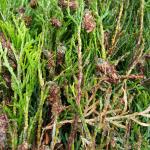 Bagworm caterpillar feeding is underway! A sample of emerald green arborvitae from Hampshire County was submitted to the UMass Plant Diagnostic Laboratory on 7/23/2024, filled with bagworm caterpillars. Browning of foliage was evident from their feeding. A population of this size can easily work its way down a hedge, defoliating the plants as they go. By August, caterpillars and their associated bags will be very large, and the defoliation and feeding damage on host plant leaves they can cause will be quite noticeable by then.
Bagworm caterpillar feeding is underway! A sample of emerald green arborvitae from Hampshire County was submitted to the UMass Plant Diagnostic Laboratory on 7/23/2024, filled with bagworm caterpillars. Browning of foliage was evident from their feeding. A population of this size can easily work its way down a hedge, defoliating the plants as they go. By August, caterpillars and their associated bags will be very large, and the defoliation and feeding damage on host plant leaves they can cause will be quite noticeable by then.- Dusky Birch Sawfly second generation larvae may be present on various species of birch (Betula) at this time. Second generation adults may emerge by mid-July, laying eggs which will hatch and feeding larvae may be present until mid-September. While small trees may be defoliated by these feeding Hymenopteran caterpillars, in the majority of cases feeding by this insect rarely reaches levels where chemical intervention is necessary. Btk (Bacillus thuringiensis kurstaki) does not work on sawfly larvae.

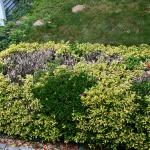 Euonymus Scale overwinters as a fertilized female. Eggs are laid beneath dark brown female scale covers in the early spring. Egg hatch occurs over a 2-3 week period, with crawlers present by early June. A second generation of crawlers may be present by mid-July, with adults present again in August and September. While Euonymus spp. host plants are preferred, additional host plants have been reported. These images are from a severe euonymus scale infestation submitted to the UMass Plant Diagnostics Laboratory.
Euonymus Scale overwinters as a fertilized female. Eggs are laid beneath dark brown female scale covers in the early spring. Egg hatch occurs over a 2-3 week period, with crawlers present by early June. A second generation of crawlers may be present by mid-July, with adults present again in August and September. While Euonymus spp. host plants are preferred, additional host plants have been reported. These images are from a severe euonymus scale infestation submitted to the UMass Plant Diagnostics Laboratory.- Fall Home-Invading Insects: Various insects, such as ladybugs, boxelder bugs, seedbugs, and stink bugs will begin to seek overwintering shelters in warm places, such as homes, throughout the next couple of months. While such invaders do not cause any measurable structural damage, they can become a nuisance, especially when they are present in large numbers. While the invasion has not yet begun, if you are not willing to share your home with such insects, now should be the time to repair torn window screens, repair gaps around windows and doors, and seal up any other gaps through which they might enter the home.
 Hickory Tussock Moth caterpillars are out and about, as is common this time of year. Lophocampa caryae is native to North America with caterpillars of this species found from July through September. These white, black and hairy caterpillars may be seen wandering landscapes. Hickory, walnut, hornbeam, and others are favored host plants, although these caterpillars may be seen on many other trees and shrubs. The hairy caterpillars themselves or their cocoons may cause dermatitis in sensitive individuals, especially children. Avoid handling and teach children to ask an adult first before picking up a hairy caterpillar. Typically does not require management.
Hickory Tussock Moth caterpillars are out and about, as is common this time of year. Lophocampa caryae is native to North America with caterpillars of this species found from July through September. These white, black and hairy caterpillars may be seen wandering landscapes. Hickory, walnut, hornbeam, and others are favored host plants, although these caterpillars may be seen on many other trees and shrubs. The hairy caterpillars themselves or their cocoons may cause dermatitis in sensitive individuals, especially children. Avoid handling and teach children to ask an adult first before picking up a hairy caterpillar. Typically does not require management.-
Locust Borer adult beetles are typically active by early September until the first frost, often associated with goldenrod. Beetles are attractive – black with a series of yellow stripes throughout the body and approximately ½-1 inches long. Black locust (Robinia pseudoacacia) is the host of the wood boring larvae of this visually striking insect.
-
Magnolia Scale reports to UMass Extension have increased as now is the time when adult female scales are large, covered in a white, waxy coating, and very noticeable. Nymphs will soon wander to the newest twigs of their host plants where they will settle to overwinter. When safe and practical to do so, such as on smaller trees, large female scales can be removed with a soft brush (without damaging the host plant bark). See link for more management options.
-

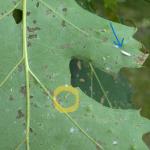
 Oak Skeletonizer populations have been noticeable in forested locations in the Williamsburg, MA area in recent years. A park tree in Ashfield, MA showed signs of the activity of this insect on 7/6/2024 as shown here. The oak skeletonizer is a native species of New England and elsewhere in the eastern United States and parts of Canada. Deciduous oaks and chestnut are hosts for this insect. Occasionally, this insect has a large outbreak population. For example, in 1971 in New York, trees were damaged by this insect by July and a second generation was found by September. In 1959 and 1960, two generations per year were observed in Michigan (Gibbons and Butcher, 1961).
Oak Skeletonizer populations have been noticeable in forested locations in the Williamsburg, MA area in recent years. A park tree in Ashfield, MA showed signs of the activity of this insect on 7/6/2024 as shown here. The oak skeletonizer is a native species of New England and elsewhere in the eastern United States and parts of Canada. Deciduous oaks and chestnut are hosts for this insect. Occasionally, this insect has a large outbreak population. For example, in 1971 in New York, trees were damaged by this insect by July and a second generation was found by September. In 1959 and 1960, two generations per year were observed in Michigan (Gibbons and Butcher, 1961).Foliage of the red oak group is skeletonized by this species. Leaves become translucent and eventually dry out. Heavily attacked foliage will appear lacey from the skeletonizing. Occasional outbreaks can cause damage over a large area, and repeated years of defoliation can cause a reduction in host plant growth. Occasionally, part of the tree crown may be killed by the activity of this insect. However, the oak skeletonizer is often found in low level, non-damaging populations and their presence can be tolerated.
Visually monitor for the activity of this insect in late May or early June (first generation). Look for skeletonized host plant leaves and eventually the characteristic white, ribbed cocoons. Trees can tolerate this native insect and often chemical management is not necessary.
-
Obscure Scale may be present on oak, chestnut, hickory, or pecan. Newly hatched crawlers may be active on infested stems and branches for a long period of time, roughly between mid-July through September. Because the scale coverings, even of dead scales, cling to the host plant bark, heavy infestations that have been present for multiple years may be detected any time of the year if the layered, encrusted scales are searched for. Take note if branches appear deformed or lumpy/misshapen.
- Pear Sawfly is an introduced (European) species that feeds on a wide variety of trees and shrubs, including pear, cherry, cotoneaster, crabapple, hawthorn, mountain ash, plum, and shadbush. Sawfly larvae feed on the leaves of their hosts, skeletonizing them at first and eventually leading to leaf browning and early leaf loss. A second generation of adult sawflies may emerge from pupal cells in the soil by August. Second generation larvae may feed on host plant leaves through September until they drop to the soil to overwinter as pupae.
- Pine Needle Scale can be a very serious pest of the needles of ornamental pines. Light infestations may go unnoticed and typically do not cause considerable damage. As a population increases, this scale insect feeds with piercing-sucking mouthparts to remove host plant fluids from the needles, causing them to eventually turn yellowish in color and possibly brown. Twigs and entire branches may eventually be killed. Lower branches typically die first. Depending upon geographic location, one or two generations of pine needle scales occur per year. If a second generation is present, second-generation crawlers are present by late July through September. Two generations per year occur in Massachusetts. More northerly locations may have a single generation per year.
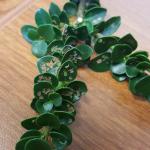
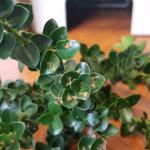 Redheaded Flea Beetle (Systena frontalis) has been identified as a native pest of nurseries in many locations in the eastern United States. Suspected redheaded flea beetle damage was seen on Ilex crenata 'Dwarf Pagoda' (Dwarf Pagoda Japanese holly) on 3/27/2024 that was purchased in Massachusetts but may have originated in NJ. While identification of this species of insect is uncertain based on host plant damage alone, it appears to be a reasonable and educated assumption. Redheaded flea beetles are known to feed on a wide variety of host plants. These include but are not limited to: cabbage, beans, beets, blueberries, and other agricultural crops as well as Physocarpus, Weigelia, Cornus, Forsythia, Itea, Hydrangea, and Ilex. Adult beetles are active and feed from approximately late-June to mid-September on the upper and lower leaf surfaces of their hosts. This can cause damage that looks like skeletonization and eventually holes in the leaves. Leaves appear covered in brown patches as in these photos. This damage was caused last season on this evergreen plant.
Redheaded Flea Beetle (Systena frontalis) has been identified as a native pest of nurseries in many locations in the eastern United States. Suspected redheaded flea beetle damage was seen on Ilex crenata 'Dwarf Pagoda' (Dwarf Pagoda Japanese holly) on 3/27/2024 that was purchased in Massachusetts but may have originated in NJ. While identification of this species of insect is uncertain based on host plant damage alone, it appears to be a reasonable and educated assumption. Redheaded flea beetles are known to feed on a wide variety of host plants. These include but are not limited to: cabbage, beans, beets, blueberries, and other agricultural crops as well as Physocarpus, Weigelia, Cornus, Forsythia, Itea, Hydrangea, and Ilex. Adult beetles are active and feed from approximately late-June to mid-September on the upper and lower leaf surfaces of their hosts. This can cause damage that looks like skeletonization and eventually holes in the leaves. Leaves appear covered in brown patches as in these photos. This damage was caused last season on this evergreen plant.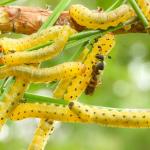
 Redheaded Pine Sawfly larvae feed on the outside of host plant needles. This results in shriveled, browned, and straw-like needles that remain attached to the hosts. Older caterpillars are capable of eating the entire needle. Feeding began in the spring and early summer, and can sometimes be extensive by the fall. Redheaded pine sawfly larvae were observed on 8/3/2024 in the Montague Sandplains (Montague and Franklin County, MA) by Dr. Paul Sievert, emeritus faculty of UMass Amherst. Parasitoid wasps possibly in the genus Exenterus were observed interacting with the larvae (see photos).
Redheaded Pine Sawfly larvae feed on the outside of host plant needles. This results in shriveled, browned, and straw-like needles that remain attached to the hosts. Older caterpillars are capable of eating the entire needle. Feeding began in the spring and early summer, and can sometimes be extensive by the fall. Redheaded pine sawfly larvae were observed on 8/3/2024 in the Montague Sandplains (Montague and Franklin County, MA) by Dr. Paul Sievert, emeritus faculty of UMass Amherst. Parasitoid wasps possibly in the genus Exenterus were observed interacting with the larvae (see photos). - Southern Pine Beetle has been trapped in Massachusetts since 2015. By 2022 and 2023, southern pine beetle has reached outbreak conditions in small areas of the state, killing pitch pine (Pinus rigida), particularly on Martha’s Vineyard and Nantucket islands in MA. If you believe you have found infested pitch pine in Massachusetts, please report southern pine beetle using the Massachusetts Southern Pine Beetle Reporting Form from MA DCR.

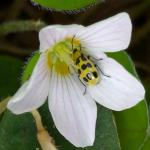 Spotted Cucumber Beetle is a pest known to impact crops such as cucumber, muskmelon, and watermelon as well as pumpkin, squash, and gourds. The adult beetles are attractive chrysomelid (leaf) beetles that are yellow in color with black spots. This insect has an impressive host list, including ornamental trees and shrubs, as well as species of clover in the genus Trifolium. However, it is most well known as a pest of vegetables and fruits. Although these images were taken in Big Sur, CA, this insect is known to the eastern United States as well, including Massachusetts.
Spotted Cucumber Beetle is a pest known to impact crops such as cucumber, muskmelon, and watermelon as well as pumpkin, squash, and gourds. The adult beetles are attractive chrysomelid (leaf) beetles that are yellow in color with black spots. This insect has an impressive host list, including ornamental trees and shrubs, as well as species of clover in the genus Trifolium. However, it is most well known as a pest of vegetables and fruits. Although these images were taken in Big Sur, CA, this insect is known to the eastern United States as well, including Massachusetts.
 Spotted Tussock Moth (Lophocampa maculata) is a native species known to both the east and west coasts of the United States. Mature caterpillars of this species are known from July through September. Host plants include basswood, cherry, elm, hazel, maple, oak, poplar, and many others (Wagner, 2005). This species is not typically a significant pest of its host plants and management may not be necessary. It is more of a curiosity, due to its bright and beautiful coloration. As with most tussock moths, discourage the handling of these hairy caterpillars by children. Some sensitive individuals may react (dermatitis) to the hairs.
Spotted Tussock Moth (Lophocampa maculata) is a native species known to both the east and west coasts of the United States. Mature caterpillars of this species are known from July through September. Host plants include basswood, cherry, elm, hazel, maple, oak, poplar, and many others (Wagner, 2005). This species is not typically a significant pest of its host plants and management may not be necessary. It is more of a curiosity, due to its bright and beautiful coloration. As with most tussock moths, discourage the handling of these hairy caterpillars by children. Some sensitive individuals may react (dermatitis) to the hairs.-
Tuliptree Aphid is a native North American insect that occurs wherever the tuliptree grows. Depending upon local temperatures, these aphids may be present from mid-June through early fall. There are several generations per year. The tuliptree aphid can cause reduced leaf size as a result of its feeding. These insects feed on their host plants with piercing-sucking mouthparts which they use to remove host plant fluids. Some leaves, especially those in the outer canopy, may turn brown or yellow and drop from infested trees prematurely.
The most significant impact these aphids can have is typically the resulting honeydew, or sugary liquid excrement, which may be present in excessive amounts and coat leaves and branches, leading to sooty mold growth. This honeydew may also make a mess of anything beneath the tree, including sidewalks and parked cars. Ants, bees, wasps, and flies may be attracted to and feed on the honeydew. Management is typically not necessary, as this insect does not significantly impact the overall health of its host.
- Viburnum Leaf Beetle larvae may be found anywhere on the leaves and usually in groups. When young, larvae feed on the undersides of the leaves. As they grow larger, they may feed on the upper surface. Larval development may take approximately 8-10 weeks to complete and 3 larval instars are reported. Pupae are yellowish and are found in the soil beneath the host plant. Adults emerge around the middle of July and are brown, smaller than the largest larvae (approximately ¼ inch), and will also feed on the leaves. Adults are present in the landscape until the first hard frost.
- White Marked Tussock Moth is one of many native tussock moth species commonly encountered in the late summer and early fall. Avoid touching these caterpillars or their cocoons: they may cause allergic reactions, especially if their hairs come into contact with sensitive skin (ex. back, stomach, underside of arms) (Wagner, 2005). Contact dermatitis (itching) as a result of interacting with these insects has been reported from schools and daycares. Teach children how to identify and avoid handling cocoons and caterpillars. These caterpillars have urticating (irritating) hairs. Welts may appear on the skin within minutes, but subside the next day; however, itching can last for several days depending upon the sensitivity of the individual.
-
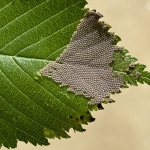 Winter Cutworm Eggs: the eggs of Noctua pronuba or the winter cutworm (caterpillar stage) or the large yellow underwing (moth stage) are being seen again on various landscape ornamental and shade trees and shrubs. See photo of the winter cutworm eggs viewed on Japanese elm on 8/22/2024 courtesy of Brady Yacek. This (until now) mysterious appearance of eggs, followed by very minor feeding on leaves (if laid on leaves) and apparent disappearance of the culprit has occurred this time of year for the last few seasons. With the help of Charley Eiseman and Whitney Cranshaw in 2023, the identity of the eggs is finally known. The winter cutworm is a non-native insect that may feed on a variety of plants in the landscape. Larvae mature by the winter and can be seen on mild days in the snow! Pupation is believed to occur in the spring, with adults found in the spring and again in the late summer. There may be two generations per year, but the life cycle of this insect is not completely understood. Increasingly, winter cutworm caterpillars are reported in Massachusetts throughout the winter season (see the Insects section under Turf in the April 7, 2023 Issue of the Landscape Message). The good news is, even though the eggs of this species have been observed on beautyberry, beech, and Japanese white pine in ornamental landscapes in recent years, no significant feeding damage has been seen on these plants. In most cases, although noticeable, the egg masses can be ignored or tolerated.
Winter Cutworm Eggs: the eggs of Noctua pronuba or the winter cutworm (caterpillar stage) or the large yellow underwing (moth stage) are being seen again on various landscape ornamental and shade trees and shrubs. See photo of the winter cutworm eggs viewed on Japanese elm on 8/22/2024 courtesy of Brady Yacek. This (until now) mysterious appearance of eggs, followed by very minor feeding on leaves (if laid on leaves) and apparent disappearance of the culprit has occurred this time of year for the last few seasons. With the help of Charley Eiseman and Whitney Cranshaw in 2023, the identity of the eggs is finally known. The winter cutworm is a non-native insect that may feed on a variety of plants in the landscape. Larvae mature by the winter and can be seen on mild days in the snow! Pupation is believed to occur in the spring, with adults found in the spring and again in the late summer. There may be two generations per year, but the life cycle of this insect is not completely understood. Increasingly, winter cutworm caterpillars are reported in Massachusetts throughout the winter season (see the Insects section under Turf in the April 7, 2023 Issue of the Landscape Message). The good news is, even though the eggs of this species have been observed on beautyberry, beech, and Japanese white pine in ornamental landscapes in recent years, no significant feeding damage has been seen on these plants. In most cases, although noticeable, the egg masses can be ignored or tolerated. - Yellow Poplar Weevil is also known as the sassafrass weevil, the magnolia leafminer, or the tulip tree leafminer. This insect, as all of these common names suggest, feeds on yellow poplar (tulip tree; Liriodendron tulipifera), sassafras (Sassafras albidum), magnolia (Magnolia spp.), as well as bay laurel (Laurus nobilis). Adult beetles lay eggs in the midribs of host plant leaves by May, after which the eggs hatch and larvae feed by creating blotch mines in the leaves. Larvae can be observed in May and June, and adults emerging to feed again by August, prior to overwintering in sheltered areas.
Beneficials/Non-Pests:
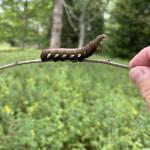 Pandorus Sphinx Caterpillars are native to Massachusetts and much of the eastern United States. Eumorpha pandorus caterpillars come in at least 4 different color forms; the darkest cinnamon brown is shown here. Other color forms include green, orange, or pink bases with pale white to yellow spots around the spiracles (breathing holes) on the abdominal segments A3-A7. Host plants of this species include Amelopsis (peppervine), grape, and Virginia creeper. These caterpillars are often encountered by people once they begin the behavior of wandering to find a suitable pupation location (Wagner, 2005). The adult form is an attractive sphinx moth. These insects do not typically cause notable damage to their host plants and should be preserved.
Pandorus Sphinx Caterpillars are native to Massachusetts and much of the eastern United States. Eumorpha pandorus caterpillars come in at least 4 different color forms; the darkest cinnamon brown is shown here. Other color forms include green, orange, or pink bases with pale white to yellow spots around the spiracles (breathing holes) on the abdominal segments A3-A7. Host plants of this species include Amelopsis (peppervine), grape, and Virginia creeper. These caterpillars are often encountered by people once they begin the behavior of wandering to find a suitable pupation location (Wagner, 2005). The adult form is an attractive sphinx moth. These insects do not typically cause notable damage to their host plants and should be preserved.
Report by Tawny Simisky, Extension Entomologist, UMass Extension Landscape, Nursery & Urban Forestry Program
Landscape Weeds
For information about identification of weeds noted below, check out UMass Extension's Weed Herbarium.
Common reed or phragmites, Phragmites australis, is now in flower in New England, so now is the time for herbicide treatment. Glyphosate-based herbicide products are the best choice for the control of common reed. In areas near water, a formulation of glyphosate that is labeled for these areas should be used. Common reed is commonly associated with water and wet habits. so controls implemented in these areas will likely invoke the Massachusetts Wetland Protection Act 310 CMR 10.00 and the management of this invasive plant will require a permit. See additional comments about 310 CMR 10.00 in the Japanese knotweed paragraph below.
Crabgrass management in turf: Summer is in its late stage and so is the growth and development of crabgrass in turf settings. As crabgrass grows and produces more tillers, options for effective control decrease. At this point in the season, most crabgrass is 5-tiller or larger. For control of these large, several tiller crabgrass plants, the use of quinclorac (Drive WLR8TM or other post-patent products) should be considered. Applications will require the addition of a high-quality MSO (methylated seed oil) surfactant for effective control. The late season control of crabgrass with quinclorac still has the chance to stop flowering and the subsequent production of seed that will be added to the weed seed bank for coming years. Sometimes referred to as a “rescue application”, late season crabgrass control will get crabgrass out of the way in preparation for late summer and early fall overseeding.
English ivy (Hedera helix): I have received several inquiries about whether English ivy (Hedera helix) is invasive in Massachusetts. These inquiries also ask about the best way to control English ivy. The Massachusetts Invasive Plant Advisory Committee (MIPAG) has not evaluated English ivy for invasiveness in Massachusetts. While this species is non-native, it would likely fall short of meeting some of the criteria that would make it designated as invasive, likely invasive, or potentially invasive. A full evaluation of this species would not likely show this plant to 1) demonstrate the potential for rapid and widespread dispersion and establishment, 2) have the potential to disperse over spatial gaps, and 3) exist in high numbers in natural plant communities and minimally managed habitats. MIPAG defines an invasive plant as a non-native species that can spread into native or minimally managed plant systems in Massachusetts. These plants cause economic or environmental harm by developing self-sustaining populations and becoming dominant and/or disruptive to those systems. Early during the evaluation of a plant species, a well-known nurseryman in Massachusetts coined the phrase “garden thug” which appropriately describes the behavior English ivy in New England. Management of a “garden thug” certainly can be justified in some situations. Initial research done in eastern Europe and repeated by Dr. Joe Neal at North Carolina State University showed that effective control of English ivy was achieved with a postemergence application of glyphosate in the spring. Applications of a 41% glyphosate formulation at 4 to 5% should be applied when the new-season growth is 3 to 5 inches long and has 3 to 5 leaves. At least 2 or 3 years of a spring application are usually required for complete control.
Japanese knotweed (Fallopia japonica): Japanese knotweed is in flower now, which is the best time for treatment with an herbicide. The treatment window begins at the first sign of floral structure development, continues through the flowering period, and ends before the first frost. Since knotweed commonly grows in wet areas or near streams, rivers or wetlands, the management of this invasive plant may invoke 310 CMR 10.00, the Massachusetts Wetlands Protection Act. 310 CMR 10.00 regulates all activities in the resource areas identified in the act. Before any management activities can begin, the Conservation Commission in that municipality should be contacted to determine to what extent 310 CMR 10.00 might impact the project. Working within the constraints of 310 CMR 10.00 can take time, so now is the time to begin that process to allow for the treatment of Japanese knotweed in a timely manner.
Report by Randy Prostak, Weed Specialist, UMass Extension Landscape, Nursery, and Urban Forestry Program
Additional Resources
Pesticide License Exams by the MA Dept. of Agricultural Resources (MDAR) are now held online. For more information and how to register, go to: https://www.mass.gov/pesticide-examination-and-licensing.
To receive immediate notification when the next Landscape Message update is posted, join our e-mail list or follow us on Facebook.
For a complete listing of landscape, nursery, and urban forestry program upcoming events, see our calendar at https://ag.umass.edu/landscape/upcoming-events.
For commercial growers of greenhouse crops and flowers - Check out UMass Extension's Greenhouse Update website.
For professional turf managers - Check out our Turf Management Updates.
For pollinator interests - Check out the Pollinator Buzz.
For home gardeners and garden retailers - Check out our home lawn and garden resources.
Diagnostic Services
UMass Laboratory Diagnoses Landscape and Turf Problems - The UMass Extension Plant Diagnostic Lab is available to serve commercial landscape contractors, turf managers, arborists, nurseries and other green industry professionals. It provides woody plant and turf disease analysis, woody plant and turf insect identification, turfgrass identification, weed identification, and offers a report of pest management strategies that are research based, economically sound and environmentally appropriate for the situation. Accurate diagnosis for a turf or landscape problem can often eliminate or reduce the need for pesticide use. For sampling procedures, detailed submission instructions and a list of fees, see the Plant Diagnostic Laboratory web site.
Soil and Plant Nutrient Testing - The University of Massachusetts Soil and Plant Nutrient Testing Laboratory is located on the campus of the University of Massachusetts at Amherst. Testing services are available to all. The lab provides test results and recommendations that lead to the wise and economical use of soils and soil amendments. For more information, including current turn-around times, visit the UMass Soil and Plant Nutrient Testing Laboratory web site. The lab is currently accepting orders for Routine Soil Analysis (including optional Organic Matter, Soluble Salts, and Nitrate testing), Particle Size Analysis, Pre-Sidedress Nitrate (PSNT), Total Sorbed Metals, and Soilless Media (no other types of soil analyses available at this time). Check for current turnaround time. Please plan for the fact that date of receipt in the lab is affected by weekends, holidays, shipping time, and time for UMass Campus Mail to deliver samples to the lab.
Tick Testing - The UMass Center for Agriculture, Food, and the Environment provides a list of potential tick identification and testing options at https://ag.umass.edu/resources/tick-testing-resources.
Acknowledgements: UMass Extension gratefully acknowledges the support of the following funding sources for the production of the Landscape Message –
- The Massachusetts Nursery and Landscape Association Fund
- The Massachusetts Department of Conservation and Recreation, Award #ISADCR28219926UMA24A
- Stakeholders like you! The Landscape Message is partially supported by educational program user fees.